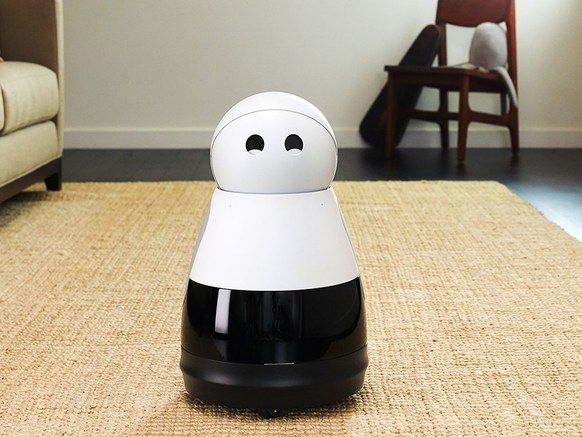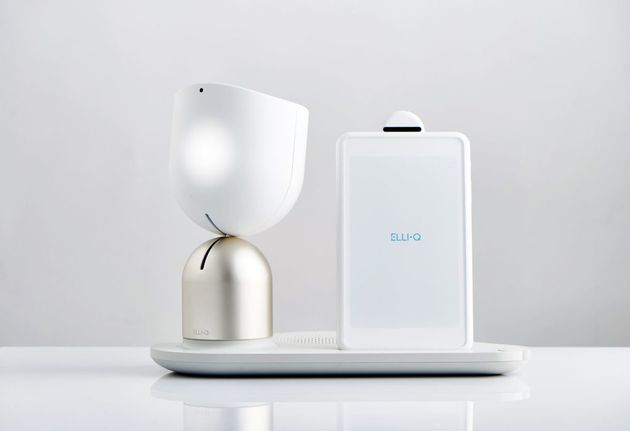By Margaret Rhodes for WIRED.

2017 is poised to be the year of the robot assistant. If youre in the market, youll have plenty to choose from. Some look like descendants of Hondas Asimo shiny white bots with heads, eyes, arms, and legs. Ubtechs Lynx has elbows, knees, and hands, which it can use to teach you yoga poses, of all things, while Hanson Robotics Sophia bot approaches Ex Machina-levels of believability. Others, like Amazons Alexa and Google Home, have no form. They come baked into simple speakers and desktop appliances. It seems most robot helpers take one of these two shapes:humanoid or monolithic.
Yet, a middle ground is emerging one with just a hint of anthropomorphism. LGs Alexa-powered Hub robot has a body with a gently nipped in waist, and a screen with two blinking eyes. ElliQ, a tabletop robot assistant for the elderly that debuted last week at the Design Museum in London, features an hourglass-shaped body and a head that swivels. Kuri, a penguin-like helper from Mayfield Robotics, scoots around and looks at you but doesnt speak. This is all deliberate. Designers and roboticists say a suggestion, rather than a declaration, of anthropomorphism could help people form closer connections with their robot assistants.
But dont overdo it the more like C-3PO your robot looks, the greater the risk of disappointment. The Hollywood robot comes with a lot of baggage, says Shyam Sundar, founding director of the Media Effects Research Lab at Penn State. Sundar and his team study peoples reception of social robots, and found that robots that appear too human not in a creepy, uncanny-valley sort of way, but in their abilities inevitably encourage unrealistic expectations. Most of them, for example, cant open a door, or help you unpack groceries, but arms and a sense of awareness would suggest they can. The critical thing for a robot assistant is information access, being a butler who fetches information or who places a phone call, Sundar says. For those things, human morphology is not only irrelevant, its also distracting.

Amazon Echos featureless,cylindrical form factor is actually an advantage. The device is so plain it all but dissolves from view, letting Alexa the AI of the operation work. Indeed, Alexa doesnt even need Echo to do its job; the voice assistant will soon inhabit a variety of third-party devices, from speakers to refrigerators. The Echo, and any other product Alexa animates, is merely a vessel.
But some human traits could be a good thing. If you get the balance right, people will like interacting with the robot, and will stop using it as a device and start using it as a social being, says Kate Darling, who studies human-robot interactions at MITs Media Lab.
ElliQ, for instance, emotes by bobbing and rotating her head. Israeli startup Intuition Robotics created her for older users, to help connect them to their families and engage in activities around the home. This range of motion, coupled with a female voice that CEO Dor Skuler says adapts to user preferences, constitutes her character. His team took pains to avoid giving ElliQ humanoid features, but the result was far from expressionless. It looks like it has a face even though it doesnt, says usability guru Don Norman, who advised Skuler on ElliQs design. That makes it feel approachable.

Too many of these characteristics leads to anthropomorphic overload. Kuris designers tried to avoid this by programming him to emit tones instead of words. He has eyes, but not a mouth that would be creepy, say Josh Morenstein and Nick Cronan, co-founders of Branch Creative. Mayfield Robotics told them that their chief objective was to make Kuri adorable. So Morenstein and Cronan worked with a Pixar animator to hone the shape and angle of Kuris eyes. Just by moving things a few millimeters, it went from looking like a dumb robot to a curious robot to a mean robot, Cronan says. It became a discussion of, how do we make something thats always looking optimistic and open to listen to you? Same goes for Kuris drawn-on shoulders, which angle forward to suggest attentiveness.
In other words: A little bit goes a long way. We seem to be biologically hardwired to anthropomorphize anything, Darling says. Even giving an inanimate object a name can make a human feel attached to it, she says. Its a very easy thing to harness. The question is just, how well are you harnessing that?
The other question: For whom are designers harnessing it? The right amount of anthropomorphism could encourage more or different kinds of interaction from users. Those interactions strengthen the robots intelligence, which benefits manufacturers, but maybe not all users. Darling points to the military. When soldiers develop a pet-like fondness for a robot, or see the robot as an extension of themselves, it can influence split-second decisions in the field. That could prove inefficient, or even dangerous. At the same time, those feelings of sympathy could improve the quality of life for someone with a failing memory.
In the months and years ahead, social robots will only become more commonplace. But what theyll look like, and how theyll behave, has yet to crystallize. What do we think a robot is? Norman says. Some people think it should look like an animal or a person, and it should move around. Or it just has to be smart, sense the environment, and have motors and controllers. The answer might lie somewhere in between.
More from Wired:

Read more: www.huffingtonpost.com





![[Video] How to get rid of bed bugs in Toronto](https://www.thehowtozone.com/wp-content/uploads/2019/10/maxresdefault-2-100x70.jpg)


